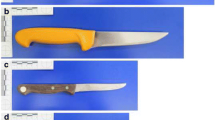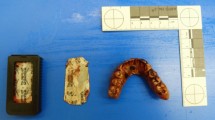Abstract
In a knife attack the perpetrator can unintentionally injure his own hand, if the knife does not have an adequate handguard and the tip of the blade hits a solid, mostly bony structure while being violently thrust into the victim’s body. The injuries occurring under these conditions are localized on the flexor side of the knife-holding hand and may include the index, middle, ring and little fingers. They are seen particularly often on the little finger at the level of the proximal phalanx and in the skin fold of the proximal interphalangeal joint. The majority of these cuts run transversely to the longitudinal axis of the fingers and can show a step-like arrangement with different distances to the metacarpophalangeal joints, often from ulnar-proximal to radial-distal. In the six cases presented the injuries were most pronounced on the ulnar side of the hand. When the flexor tendons of the fingers are also severed and the tendon stumps are strongly retracted this indicates that the fist was firmly closed at the time of the injury.






Similar content being viewed by others
References
Armenta E, Lehrman A (1980) The vincula to the flexor tendons of the hand. J Hand Surg [Am] 5:127–134
Bajanowski T, Varro A, Sepulchre M-A (1991) Tod durch scharfe Gewalt. Kriminologische und kriminalistische Aspekte. Arch Kriminol 187:65–74
Bajanowski T, Köhler H, Schmidt PF, Salden C-F von, Brinkmann B (2001) The cloven hoof in legal medicine. Int J Legal Med 114:347–348
Banasr A, Lorin de la Grandmaison G, Durigon M (2003) Frequency of bone/cartilage lesions in stab and incised wounds fatalities. Forensic Sci Int 131:131–133
Bauer J, Eisenmenger W, Schweiberer L (1986) Das Verletzungsmuster von Messerstichen und Schussverletzungen in der Notaufnahme. Kriminalistik 40:16–18
Bauer M, Patzelt D (2002) Intracranial stab injuries: case report and case study. Forensic Sci Int 129:122–127
Behrendt N, Buhl N, Seidl S (2002) The lethal paraphiliac syndrome: accidental autoerotic deaths in four women and a review of the literature. Int J Legal Med 116:148–152
Boyer MI, Strickland JW, Engels DR, Sachar K, Leversedge FJ (2003) Flexor tendon repair and rehabilitation: state of the art in 2002. Instr Course Lect 52:137–161
Brug E, Langer M, Probst A (2000) Die Verletzungen der Beuge- und Strecksehnen im Handbereich. Orthopäde 29:216–227
Castro WHM, Meyer SJ, Becke MER et al. (2001) No stress—no whiplash? Prevalence of “whiplash” symptoms following exposure to a placebo rear-end collision. Int J Legal Med 114:316–322
Chadwick EKJ, Nicol AC, Lane JV, Gray TGF (1999) Biomechanics of knife stab attacks. Forensic Sci Int 105:35–44
Eisenmenger W (2004) Spitze, scharfe und halbscharfe Gewalt. In: Brinkmann B, Madea B (eds) Handbuch gerichtliche Medizin, vol 1. Springer, Berlin Heidelberg New York, p 581
Faller-Marquardt M, Hellerich U, Pollak S (1999) Berufsbezogene Vorgehensweise bei Selbstverletzung im Rahmen eines fingierten Überfalls. Arch Kriminol 203:129–137
Große Perdekamp M, Bohnert M, Pollak S (2000) Zur Kasuistik der akzidentellen Herzstichverletzung. Arch Kriminol 205:169–176
Herbst J, Hoppe B, Haffner H-T (1999) Kriterien der Fremd- oder Selbstbeibringung bei Todesfällen durch scharfe Gewalt. Rechtsmedizin 10:14–20
Kaatsch H-J, Mehrens C, Nietert M (1994) Untersuchungen zur Biomechanik bei Stichvorgängen. Rechtsmedizin 4:91–98
Karger B, Niemeyer J, Brinkmann B (2000) Suicides by sharp force: typical and atypical features. Int J Legal Med 113:259–262
Karger B, Vennemann B (2001) Suicide by more than 90 stab wounds including perforation of the skull. Int J Legal Med 115:167–169
Karger B, Billeb E, Koops E, Brinkmann B (2002) Autopsy features relevant for discrimination between suicidal and homicidal gunshot injuries. Int J Legal Med 116:273–278
Karlsson T (1998) Homicidal and suicidal sharp force fatalities in Stockholm, Sweden. Forensic Sci Int 93:21–32
Kwan O, Friel J (2002) Whiplash sine whiplash. Int J Legal Med 116:249–250
Metter D, Benz D (1989) Abwehrverletzungen bei Tötungsdelikten durch scharfe Gewalteinwirkung. Z Rechtsmed 102:277–291
Pollak S, La Harpe R (1992) Geformte Kontusionsmarken durch das Messerheft. Arch Kriminol 190:1–8
Pollak S, Saukko PJ (2000) Defense wounds. In: Siegel JA, Saukko PJ, Knupfer GC (eds) Encyclopedia of forensic sciences. Academic Press, London, pp 374–378
Pollak S, Saukko PJ (2003) Atlas of forensic medicine. Elsevier, Amsterdam
Prokop O, Göhler W (1975) Forensische Medizin, 3rd edn. Volk und Gesundheit, Berlin, p 176
Sasaki Y, Nomura S (1987) An unusual role of the vinculum after complete laceration of the flexor tendons. J Hand Surg [Br] 12:105–108
Schmidt H-J, Lanz U (2003) Chirurgische Anatomie der Hand, 2nd edn. Thieme, Stuttgart, p 195
Siegmund GP, Brault JP, Wheeler JB (2002) Placebo whiplash data need cautious interpretation. Int J Legal Med 116:251
Weber W (1974) Quantitative investigations concerning penetrating wounds of the human skull. Z Rechtsmed 74:111–116
Author information
Authors and Affiliations
Corresponding author
Additional information
Dedicated to Prof. Dr. Dr. h. c. B. Brinkmann on the occasion of his 65th birthday.
Rights and permissions
About this article
Cite this article
Schmidt, U., Faller-Marquardt, M., Tatschner, T. et al. Cuts to the offender’s own hand—unintentional self-infliction in the course of knife attacks. Int J Legal Med 118, 348–354 (2004). https://doi.org/10.1007/s00414-004-0491-y
Received:
Accepted:
Published:
Issue Date:
DOI: https://doi.org/10.1007/s00414-004-0491-y




